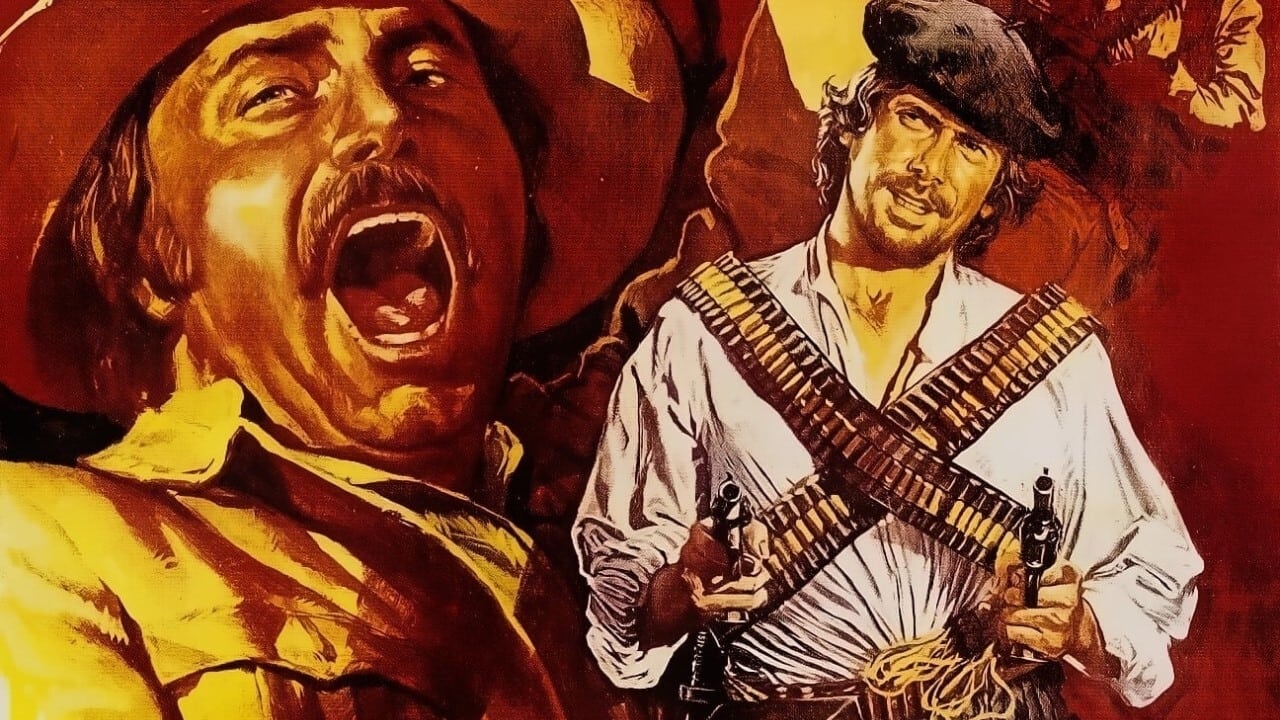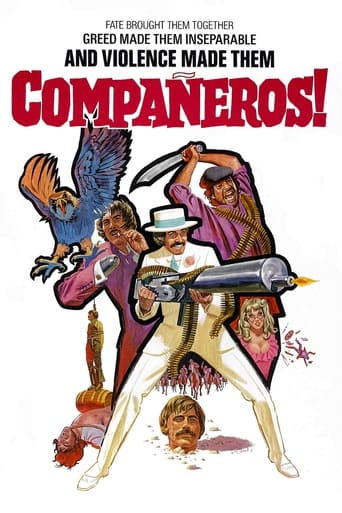

recommended
... View MoreOne of the worst movies I've ever seen
... View MoreDon't Believe the Hype
... View MoreIf you're interested in the topic at hand, you should just watch it and judge yourself because the reviews have gone very biased by people that didn't even watch it and just hate (or love) the creator. I liked it, it was well written, narrated, and directed and it was about a topic that interests me.
... View MoreYou want action, you got action. We were all literally knocked out of our socks at the preview screening. True, "Companeros" makes a not particularly certain start. The English dubbing certainly doesn't help, but some of the players, particularly Iris Berben and the students, seem to be taking the script seriously, whereas everyone else is hamming it up no end, playing the whole thing as broad farce. Mr. Rey when he comes on, is also cast in serious mode, though he does make an effective contrast. Bodalo is great as General Mongo, though some of his dialogue could be trimmed to advantage. His speeches all owe their effectiveness more to his energetic hamming than to any latent wit in the writing.Though the early scenes have their intriguing moments, the film doesn't really get into stride until Jack Palance appears, about 30 minutes in. It's at this point that any pretense of seriousness is irrevocably cast aside. We are then free to enjoy the stunning locations, fast cutting of marvelous 'Scope images strung together by Morricone's typically rousing thematic and choral score, — and of course the splendidly staged action fights with our heroes brawling their comic-strip way out of one spectacular scrape after the other.
... View MoreNot in any way is this meant to sound biased, because actually there are some truly great spaghetti westerns out there. Companeros may not be one of the absolute best of them, but to me it's among the most fun. It is a little of a slow-starter and a touch episodic at first and it's less than original, but when the rest of the film is so much fun and so well put together they don't seem to matter.Companeros is a brilliantly made film, with gorgeously evocative scenery and costumes and stylish cinematography that give off a dream-like quality and harsh realism. Sergio Corbucci's direction as to be expected is exemplary, it's technically faultless while never getting in the way of the storytelling. Ennio Morricone's music score will not disappoint any fans of his and is one of the film's best assets, it's not quite one of his all-time greats but it's haunting and stirring and the theme song is one of the catchiest theme songs for any film. Like almost all his work, it really gives the film soul. Companeros is smartly scripted filled with subtle witty humour, it has blistering action especially one of the most suspenseful and entertaining shoot-out scenes I've ever seen for a film and the story is exciting, tense and fun-filled with a truly sensational and quite emotional ending.The cast is a talented one and Companeros in no way wastes the actors. Particularly good is Jack Palance, here he has one of his most loathsome characters and Palance's performance is devilishly enjoyable, clearly looking like he was having a ball. While he is a scene-stealer, Franco Nero and Tomas Milian do wonderfully in the lead roles too, in performances filled with charisma and likability, and work like dynamite together in a film where their chemistry ties it together. Overall, a great film and a huge lot of fun to watch. 9/10 Bethany Cox
... View MoreIn 1968, Sergio Carbucci directed "The Mercenary" (also called "A Hired Gun"). It starred Franco Nero and one of the baddies was played by Jack Palance. And, the story was about an amoral European who comes to Mexico during the civil war to make his fortune--regardless of who he helps. Now, Carbucci does something radically different! Instead, it stars Franco Nero as an amoral European trying to sell arms to folks during the Mexican civil war--and one of the baddies trying to stop him is, gasp, Jack Palance!! Huh?! In other words, Crabucci pretty much made the same film all over again--with a few minor cast changes (such as Tomas Milian cast instead of Tony Musante) and the addition of the Professor character (Fernando Rey). And, like the other film, the plot has a bit of comedy, there's TONS of killing and the film has a decidedly populist bent. Because the film is essentially a re-tread and the music is a bit too repetitive and annoying, I really can't recommend this film unless you are such a huge fan of Italian westerns that you must catch 'em all (sort of like Pokemon, huh?). As for me, I wish I hadn't bothered. I probably should have just watched "The Mercenary" twice...as it was a bit better and more original.
... View More"Vamos A Matar, Compañeros" is another terrific and indescribably entertaining Spaghetti-western from the talented hands and brains of Sergio Corbucci ("Django", "The Great Silence"). Damn, what a fun movie this was! This film amazingly pairs two of the coolest and most brilliant contemporary Italian acting icons in the genre (Franco Nero & Tomas Milian); it has the catchiest Ennio Morricone score imaginable, a sublime albeit unobtrusive "Viva the Revolution" atmosphere, delightfully insane villains and a pleasing amount of exhilarating & violent shootouts. Franco Nero plays a smooth-talking Swedish weapon salesman, dealing with the corrupt & greedy army General Mongo. Tomas Milian is an ennobled street bandit also fighting for Mongo. They team up reluctantly to kidnap a certain professor Xantos, who teaches his youthful students to fight a bloodless revolution, but once they found and freed him from his prison cell, the way back to San Bernardino is still very long and full of obstacles, like defeating a marijuana-addicted criminal (the always-amazing Jack Palance!) with an artificial hand and a loyal pet-falcon. "Compañeros" is just pure fun! It's definitely not as sophisticated as Sergio Leone's Spaghetti Western efforts and not even as politically engaged as most revolutionary westerns, but its entertainment value is enormous! The on screen chemistry between Franco & Milian is irresistible, mostly because they constantly argue and try to abandon each other, and whenever the action sequences are about to kick in the splendid title song begins to play. Jack Palance is deliciously OTT as loathsome gangster, while Iris Berben (as Lola the cherubic freedom-fighter) and Karin Schubert (as Zaïra the helpful prostitute) provide the film with some welcome eye-candy and even nudity. The script demonstrates a great and almost unique sense of humor, the filming locations are often extremely enchanting and the action sequences are rough and ingeniously filmed. "Compañeros" is a total winner and highly recommended to fans of the genre.
... View More